Standing on a concrete bridge above the Xiaoqing River, a farmer named Wu shook his head as he gazed down at the water below. Wu, who is 61, used to be able to see all the way to the bottom. And he and others in Cuijia, a village of about 2,000 in China’s Shandong province, used to swim at this very spot. There were so many turtles he could easily stab one with his forked spear, he recalled on a steamy Saturday in July. To catch some of the many fish, he simply threw a net into the water, he said, moving his arms as he spoke in a gesture that has survived in his muscle memory long after most of the fish have disappeared.
The Xiaoqing flows 134 miles through the major cities of Zibo, Binzhou, and Dongying in Shandong province. Tens of millions of people depend on it. In Jinan, which is close to the river’s origin, human and livestock waste and runoff from fertilizers and pesticides have caused the water to stink in recent years. But downstream from Jinan, waste from factories has compounded the river’s problems.
Directly translated from Chinese, the word “Xiaoqing” means “clean and clear.” But here in Cuijia, the water is neither. From the bridge, you can see debris and garbage swirling atop the forceful rush of brown. Occasionally, bits of plastic and something that looks like Styrofoam float by. But what may be most dangerous in the Xiaoqing River isn’t visible: perfluorooctanoic acid, or PFOA, long used by DuPont in the production of Teflon, among other products, and linked to cancer and other diseases. Because Cuijia lies downstream from a factory that emits more PFOA than any other industrial facility in the world, levels of the chemical at various points near here are among the highest ever reported, reaching more than 500 times the safety level the U.S. Environmental Protection Agency recently set for drinking water. The plant, operated by a company called Dongyue Group, is the world’s biggest producer of Teflon and emits 350 pounds of PFOA every day, an amount that totals 63 tons in a single year, according to a recent estimate.
DuPont and seven other companies agreed to phase out the use and production of PFOA in the United States by 2015, after lawsuits and protracted negotiations with the EPA. Keeping toxic chemicals at bay in countries that have relatively strong environmental regulations is a Herculean task that, in the case of PFOA and perfluorooctane sulfonate, or PFOS, is still underway. Though this effort can consume the energies of Western environmentalists, the story doesn’t end when they push a toxic chemical beyond their borders. In China, that’s often when a chemical’s life begins in earnest.
As we stood next to the river, Wu looked out across the landscape. He wore blue plastic sandals and baggy gray pants. A shovel, from which two empty plastic buckets hung, lay across his shoulders, and as he listened to translations of my questions he nodded slightly. He had never heard of PFOA, he said, and didn’t know the exact causes of his village’s problems. There may be many. The Dongyue plant isn’t the only factory that disposes of its waste in the water. Wu said a paper mill upstream also puts waste into the river. And Dongyue itself makes many chemicals in addition to PFOA.
But Wu understands well that something has profoundly changed the river he has relied on his whole life. For more than a decade, the people of Cuijia have watched as their crops have stopped thriving. The corn does better than the wheat, he said, but both have become harder to cultivate. Recently, his wheat crop failed altogether, imperiling his family’s meager income.
Then there’s the sickness. More and more people in Cuijia have been falling ill and dying, he said, often with cancer and at a young age. When I asked whether any of them got medical help or reimbursement for their doctors’ bills when they became sick, Wu guffawed theatrically, putting one hand over his belly and turning his face to the side, as if some invisible presence would appreciate the absurdity of my idea. After his laughter subsided, he explained that some of the villagers had recently reported the increase in pollution and cancer to the local government, but had received no response.
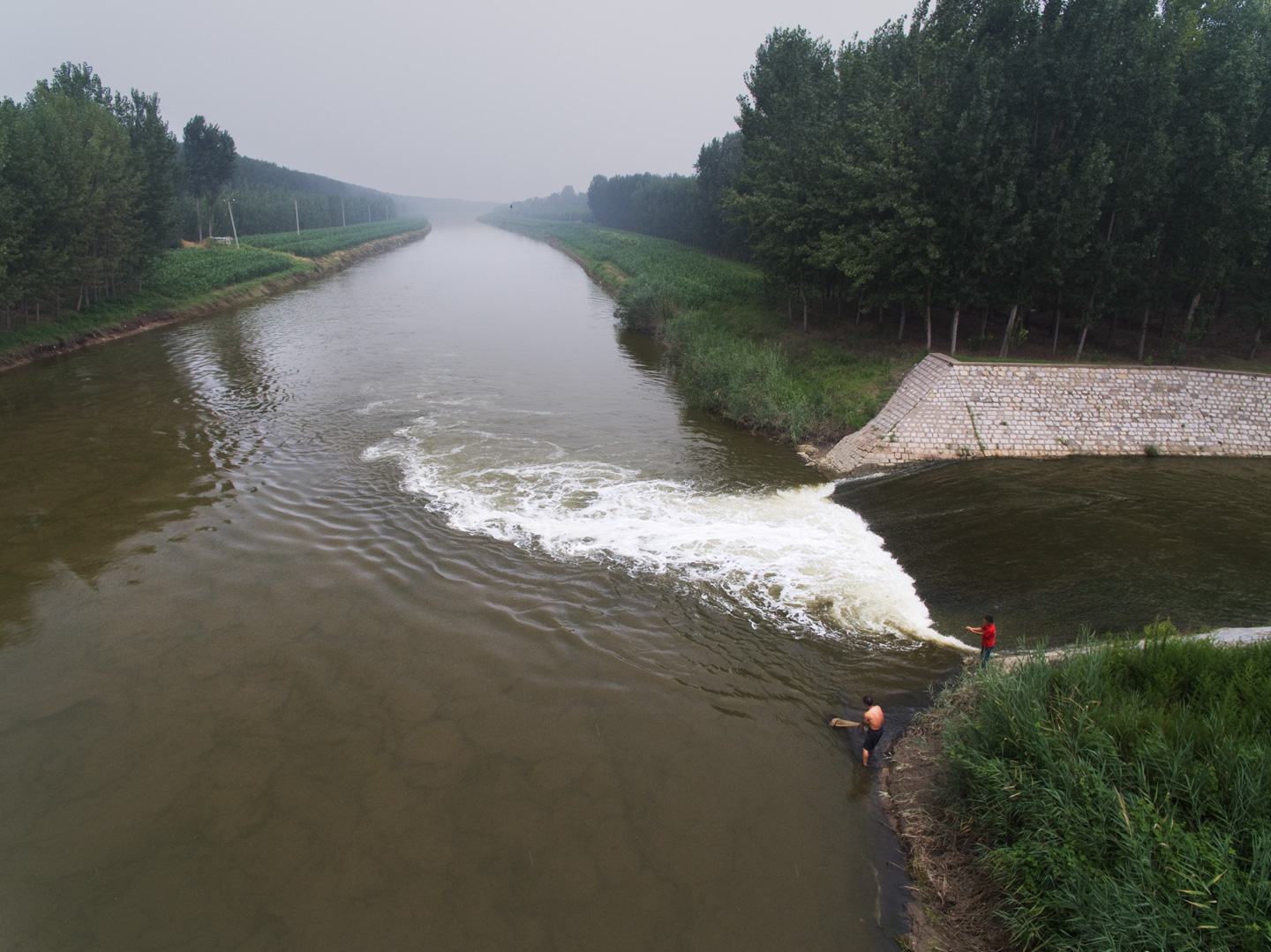
Water collected at the confluence of the Zhulong River and the Xiaoqing River tested very high for PFOA.Image: JIANG MEI/CHINA FILE/THE INTERCEPT
In 2005 a class-action suit against DuPont over contamination in West Virginia and Ohio set off the first alarms about PFOA, also known as C8 because of its 8-carbon molecule. In the intervening years, the attorney overseeing that case has waged a campaign to get the government to regulate the chemical in the U.S. But until recently, concern about perfluorinated compounds, or PFCs, in the U.S. remained the preoccupation of a small group of scientists and legal experts. It was only in the past year, as PFOS from firefighting foam was discovered in the water near hundreds of military bases, and communities around the country found PFOA and other PFCs in their drinking water, that awareness blossomed into outrage.
Around the world — from Hoosick Falls, New York, to Buck’s County, Pennsylvania, Holland, Sweden, and several parts of Australia — communities have begun to understand not only that the chemicals have been in their water for years but also that the contamination continued after industry scientists knew PFOA and PFOS persisted indefinitely in the environment, accumulated in human bodies, and affected health.
Yet by the time that information made its way to the public, the contamination was too great to be completely cleaned up, and PFCs were already in the vast majority of human bodies. A 2007 study by researchers at the Centers for Disease Control found that 99.7 percent of Americans over 12 had trace amounts of PFOA in their blood, while 99.9 percent had PFOS. The contamination begins even before birth, according to a 2006 study, which detected PFOA in 99.3 percent of umbilical cord blood.

Workers repairing a sluice on the Zhulong River fish on the Xiaoqing River during their lunch break. One worker said, "These little fish can take a lot. Ordinary pollution won't kill them.Image: JIANG MEI/CHINA FILE/THE INTERCEPT
The health consequences of this massive exposure are still coming into focus. In 2012, more than 60 years after PFOA was first produced by 3M and sold to DuPont to help make Teflon, a panel of scientists linked the chemical to thyroid disease, ulcerative colitis, preeclampsia, and high cholesterol, as well as kidney and testicular cancer. Although debate continues about the precise dangers the chemicals present and what amount — if any — is safe to ingest, researchers have seen an association between PFOA and other health problems, including decreased immune function, impaired sperm quality, and low birth weight in humans, and pancreatic and liver cancer in lab animals. A recent EPA report on PFOS and drinking water also noted possible links with bladder, colon, and prostate cancer as well as reduced fertility.
This mounting knowledge has translated into action in many places — if slowly and, some argue, inadequately. The European Union officially deemed PFOA a “substance of very high concern” in 2013, a designation reserved for chemicals that have “serious and often irreversible effects on human health and the environment.” Production and use of both chemicals has subsequently ceased throughout most of Europe, Japan, and Canada. And in response to outrage over contamination, one Australian state recently banned firefighting foam that contains PFOS.
In the U.S., an agreement between the chemical industry and the EPA brought all production and use of PFOA and PFOS to an end last year. And in May, in part because of concern in communities that had discovered PFOA and PFOS in their water supplies, the EPA came up with voluntary standards limiting the amount of both chemicals in drinking water to .07 parts per billion (ppb). This week, New Jersey’s Drinking Water Quality Institute recommended a much lower standard, .014 ppb, one-fifth that of the federal EPA. The U.S. Air Force just announced that it would replace its PFOS-containing firefighting foam with a safer substitute, and people exposed to the chemicals in their water have sued both the U.S. Navy and private companies.
Yet while most of the world was phasing out PFOA and PFOS and beginning to address the problems they had caused, the chemicals emerged in countries with fewer restrictions. There is some evidence that India and Russia have recently used PFOA to make Teflon and that Russia may also be manufacturing the chemical. But it’s in China that the business has truly boomed, keeping global output of PFOA and PFOS steady even as the industry ground to a virtual halt everywhere else.
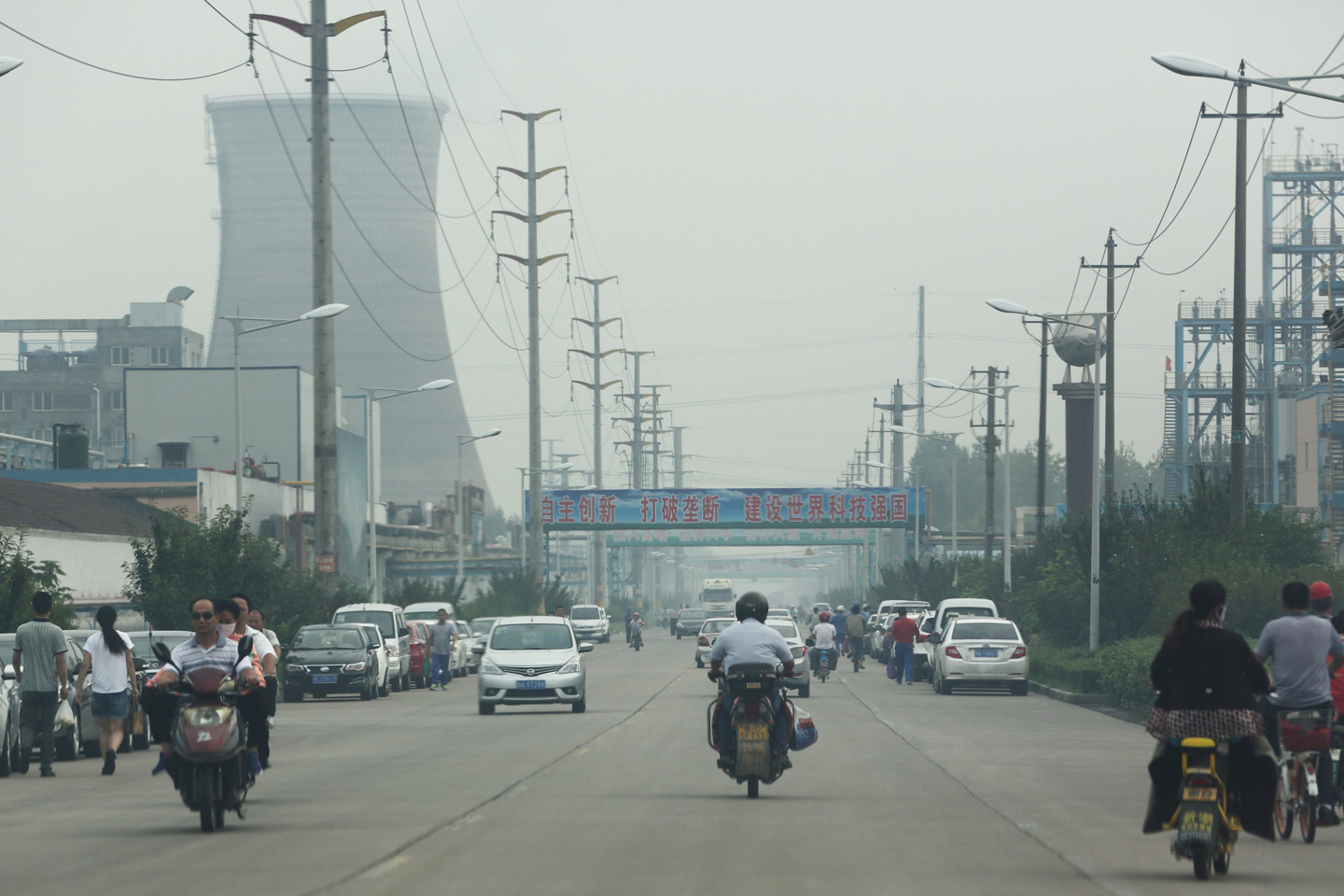
A shift change at a chemical factory owned by the Dongyue Group. Image: JIANG MEI/CHINA FILE/THE INTERCEPT
China is now the world’s biggest source of both PFOA and PFOS. Between 2004 and 2012, as the West was scaling down its PFOA production, China’s production and emissions roughly tripled, according to one 2015 study. Though it’s impossible to quantify precisely, the country now makes somewhere between 64 and 292 tons of PFOA per year, most of which is released directly into the water and air. Total PFOA emissions in China may be as high as 168 tons per year, according to one recent estimate. And both production and emissions are predicted to continue through at least 2030. China also produces somewhere between 110 and 220 tons of PFOS a year, more than any other country.
So while Teflon began as a quintessentially American brand, China now manufactures most of the world’s supply of the slippery substance, which is used in dental floss, textile fibers, wire and cable insulation, and hundreds of other products, including nonstick cookware. The Dongyue plant in Shandong used PFOA to make more than 49,000 tons of Teflon in 2013 as well as four other products, including PVDF, a compound used in the semiconductor, medical, and defense industries.
Though they’re toxic, persistent, and accumulate in human bodies, PFOA and PFOS are by no means the only contaminants China has to worry about — or the most dangerous. Heavy metals such as lead, mercury, arsenic, and cadmium, which cause cancer, lung problems, and brain damage, have made one-fifth of the country’s farmland too polluted for growing food. Air pollution, which has reached hazardous levels in at least 83 cities — and in some places, as much as 20 times recommended levels — is perhaps the country’s most visible problem and is contributing to soaring lung cancer rates.
The nation’s water crisis is just as dire. More than 80 percent of China’s underground water supply is unfit for human consumption and almost two-thirds is unfit for any human contact, according to a government report released earlier this year. Some 300 million people — almost equivalent to the entire U.S. population — lack access to clean drinking water, and an estimated 190 million have become sick from drinking water polluted with everything from pesticides to heavy metals, toxic waste, and oil spills.

The Yangtze, bustling with cargo ships.Image: JIANG MEI/CHINA FILE/THE INTERCEPT
If PFCs aren’t China’s most pressing environmental problem, they are the most pronounced example of a global pattern that helps explain how the country came to be one of the most polluted in the world.
PFOA and PFOS are just the latest in a steady stream of chemicals to make the journey to China after being cast off by countries that have deemed them unacceptably hazardous. Production of short-chain chlorinated paraffins, which are used as lubricants and coolants in metal cutting, shot up 30-fold in China as these chemicals were coming under EPA scrutiny. Similarly, China is now the world’s biggest producer of HBCD, a flame retardant the EPA recently targeted for action. And the aniline dye industry migrated from the U.S. to China after it was well established that the chemicals involved are carcinogenic.
“I call it the leftovers problem,” said Joe DiGangi, who works for IPEN, a network of organizations in 116 countries devoted to protecting health and the environment from toxic chemicals. “Often a chemical comes under public or regulatory pressure in the EU or the U.S. and then shortly thereafter, Chinese companies begin producing it,” said DiGangi. China and the other developing countries that inherit it, he said, “often don’t have the adequate infrastructure to regulate, monitor, and deal with it safely.”
This global migration of toxic chemicals across borders can help explain why the Changshu Advanced Materials Industrial Park sprang up in 2001, just as the first suit over PFOA contamination in West Virginia was being filed and PFCs were coming under the scrutiny of the EPA. Originally named the Chiangsu High-Tech Fluorine Chemical Industrial Park, the almost 6-square-mile campus in the Yangtze River Delta is home to more than 40 factories. With an output of 31,000 tons per year, it is China’s second largest source of Teflon after the Dongyue plant. Many of the factories in the park produce fluorochemicals, and several of them are operated by companies that used or made PFOA and PFOS in the U.S. until recently, such as Solvay Solexis, Arkema, and Daikin. (Solvay Solexis, Arkema, and Daikin did not respond to requests for comment.)

A motor scooter driver wearing a face mask passes by the Chemours plant in Changshu.Image: JIANG MEI/CHINA FILE/THE INTERCEPT
DuPont, which made Teflon a household name, also built a plant here in 2008 at a cost of $80 million. In July 2015, it passed the facility on to a new company called Chemours, when it spun off its performance chemical division. In July 2016, Chemours announced it would invest $15 million to expand its Changshu Works plant to augment the company’s “already considerable presence in China” and increase Teflon output. (Chemours did not respond to multiple requests for comment.)
With its own fire station and heat, water, power, sewage, and postal systems, the Changshu industrial center is like a small self-contained city. A giant modern sculpture and the flags of more than a dozen nations adorn its entrance, and manicured shrubbery lines its freshly paved roads. Changshu’s website lays out grand plans for the park, predicting that it “will become a paradise for technological development, a powerful treasure land and an ecologically harmonious auspicious land.”
But after more than a decade of operations, residents of a nearby village called Haiyu have planted corn between and around the neatly spaced buildings. Although the crop appears to be fed at least in part with wastewater, one of the villagers told me that people in Haiyu eat the corn as they always have, cooking it on the cob and grinding up whatever’s left to make dough for noodles.

A ship worker descends into a storage container to clean up chloroform after a shipment.Image: JIANG MEI/CHINA FILE/THE INTERCEPT
One family of three even made their home on one of the park’s many crisscrossing canals, mooring their old wooden boat under an overpass that a plaque identified as the “DuPont Bridge.” Although the labels on the pipes lining the canal made it clear that at least some of them carried industrial waste, the family had been living there for some time, ferrying chemicals between the factories. Their boat was festooned with drying laundry.
A short drive from DuPont Bridge, a man wearing a Paddington T-shirt bearing a picture of the bear eating a sandwich was fishing in another canal. He sat under a thatch of trees across from a factory, dangling a wooden rod into the water below as brown waves lapped at the mouth of a pipe that opened onto the stone-lined canal. The man told me he worked at one of the factories. This was a Sunday, and though he didn’t have to work, he had ridden 40 minutes on his motorbike to try his luck fishing. He’s spent most of his days off this way over the past four years. And in that short time he had noticed the number and quality of the fish in the canals worsen. That morning, it had taken several hours just to catch the six small fish in the plastic bucket beside him.
Scientists might have predicted the size and yield of his catch, since PFOA has been shown to harm fish exposed to it. The chemical causes male fish to develop female reproductive cells and the ovaries of female fish to degrade. Contaminated food may account for as much as 90 percent of human exposure to PFOA and PFOS.
There are plenty of both chemicals in this water. In fact, in 2013 the scientists measured some of the highest concentrations of PFCs ever reported in China right here in this industrial park. But the man in the Paddington shirt said he wasn’t terribly concerned. He’s careful to switch fishing spots if the water begins to smell bad or turns an odd color. He had just recently stopped fishing at a nearby canal when its water turned an electric blue. He said the fish he caught at other spots sometimes tasted bad, but these were delicious, especially when stewed with soy sauce and spices over a small fire.
Ni Jiahui, director of the Changshu park, wrote in an email that wastewater in the park was pre-treated at factories and then sent to the park’s wastewater treatment plant and that factories’ exhaust systems have to pass an environmental assessment. Ni also acknowledged in his email that boats are present in the park and that people farm and fish amid the factories. “I think having people fishing and farming in the industrial park are indications that our chemicals production has not caused any problem to the environment,” he wrote. “Otherwise no one would fish here.”
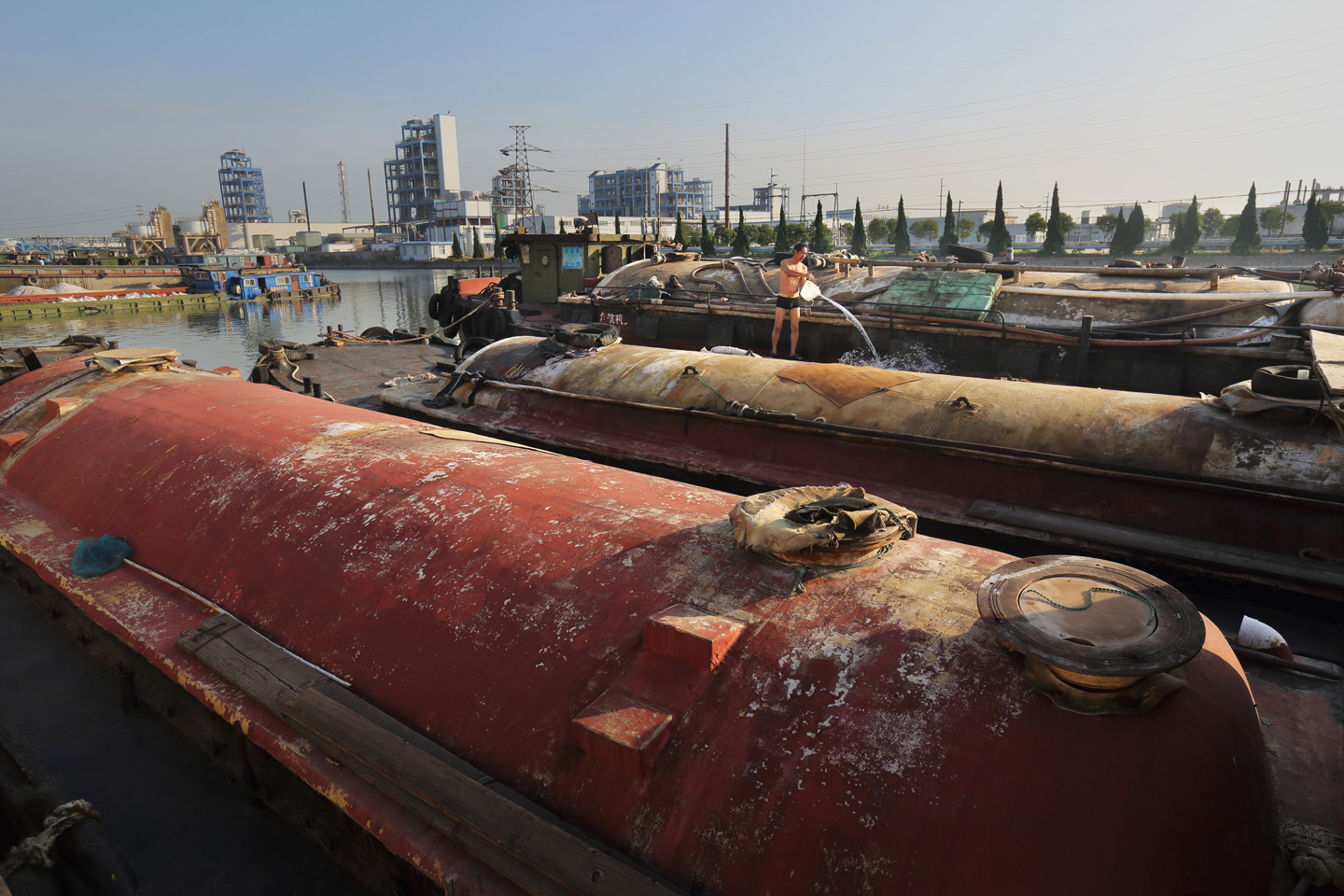
A deckhand washes a ship used to transport chemicals.Image: JIANG MEI/CHINA FILE/THE INTERCEPT
Just as in the U.S., the production of PFCs in China has been followed by a rise of the chemicals in the environment — and in people. As scientists traced the growing presence of these chemicals in water and fish, they were also able to documentincreasing levels in human blood by looking at several students and faculty members at a university in the northern city of Shenyang. Between 1987 and 2002, the level of PFOA increased 54-fold, while blood levels of PFOS increased by a factor of 747. Since then, they have crept up further, especially in factory workers and commercial fisherman.
You can also find the molecules in dust and air, as one study recently did, documenting a 12-mile plume of PFOA-contaminated air that surrounds the Dongyue plant in Shandong. The level of PFOA in the nearby Zhulong River was recently measured at 10,379 ppb, more than 148,000 times what the U.S. had deemed safe.
Yet other than guards who discouraged passing cars from slowing, nothing seemed particularly menacing about the Dongyue plant. The factory entrance was plastered with colorful billboards with reassuring English messages, such as “Safety and environmental protection are the first value of the Dongyue group,” and “Taking good care of yourself is the best love to your mother.”
Just over 5 miles away, in a small farming village called Bozhadian, the residents seemed well aware of the river’s problems. An elderly man who was ushering his herd of goats across a bridge over the Zhulong said that no one fishes in the river anymore. And the proprietor of the local corner store said simply, “The water’s not good there.”
The people I spoke with in Bozhadian hadn’t heard about the scientific studies that carefully traced the PFOA in their water back to the nearby plant. They used other numbers to describe the Dongyue factory, which provides critical employment in this village of roughly 1,000. One woman sitting on a wooden stool outside the corner store told me that her son makes 3,000 yuan per month working there. Broken down over the 20 12-hour shifts he works, the pay comes to about $1.87 an hour. It’s not much by U.S. — or even Chinese — standards. But it’s still more than he would likely make farming. Not far from where we sat, a smokestack and cooling tank towered over cornfields where, at 68, the woman still harvests and plants. She smiled proudly as she described her son’s job, which seemed to involve surveying operations while sitting at a computer.
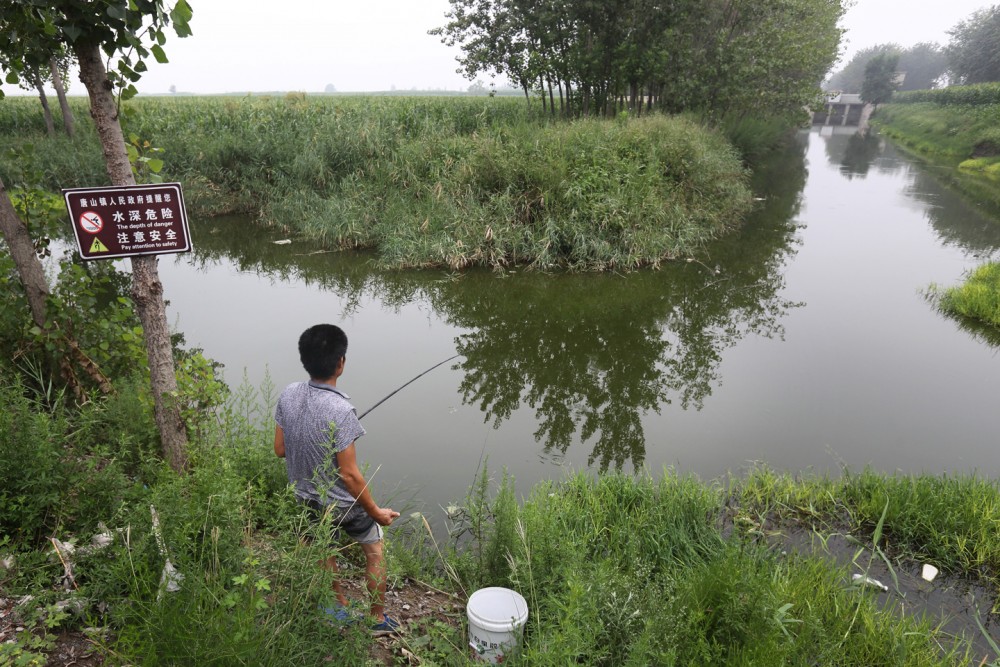
A villager fishes in a tributary of the Zhulong River, hooking fish of only about 5 centimeters. The sign reads "Chromium Slag Remediation. Image: JIANG MEI/CHINA FILE/THE INTERCEPT
Low labor costs and a lack of environmental regulation helped draw American and European chemical companies to China. Since the late 1970s, when Deng Xiaoping opened the country’s economy to the world, the chemical industry has been at the heart of its dazzling growth. In the past four decades, the Chinese chemical sector has grown faster than that of almost any other country. From 2000 to 2010, production of chemicals nearly tripled. By 2010, industry sales totaled more than $754 billion a year.
Yet knowledge of the environmental hazards of industrial chemicals — and how to address them — has not always made the trip.
Since 2006, when it first negotiated the phaseout of both PFOA and PFOS in the U.S., the EPA has also required companies to drastically reduce their emissions of the chemicals. And each of the eight companies that participated readily began recycling and incinerating PFOA after using it. Companies in Japan and Western Europe also instituted recycling.
Yet in China, these straightforward techniques of disposing of PFOA appear to be the rare exception. Scientists I contacted agreed that releasing the chemical waste directly into waterways and the air seemed to be the norm. “The best available treatment technique is not used in China despite that this would be a very cost-efficient and easy way to drastically reduce emissions of PFOA,” Robin Vestegren, an environmental researcher at Stockholm University, wrote in an email.
The Dongyue Group declined a request to be interviewed for this story, but a spokesperson wrote in an email that the company denies researchers’ claims that its emissions contribute to water pollution in the Xiaoqing River. The email also said that the Chinese government has installed a 24-hour monitoring system in its factory, and that its emissions comply with government regulations. “Dongyue values environmental protection above all things,” the company spokesperson added.
But Vestegren and his colleagues in China recently calculated how much PFOA the plant would emit based on its Teflon production, and found that the number was very close to the actual amount they measured in the Xiaoqing River. (A small amount of the chemical is also emitted through the air.) Vestegren wrote that he was confident the plant “has not installed any treatment technology.”
You can even see the differences in practice between plants belonging to the same company. In the U.S., DuPont greatly reduced its emissions of PFOA after coming under scrutiny. Workers’ blood levels dropped, too. The amount of PFOA in workers at its New Jersey plant was down to an average of 1,644 ppb by 2007 and had dropped to 1,110 by 2009. But in China, the levels of PFOA in workers’ blood reached an average of 2,250 ppb within the first year of operation of the Changshu plant.
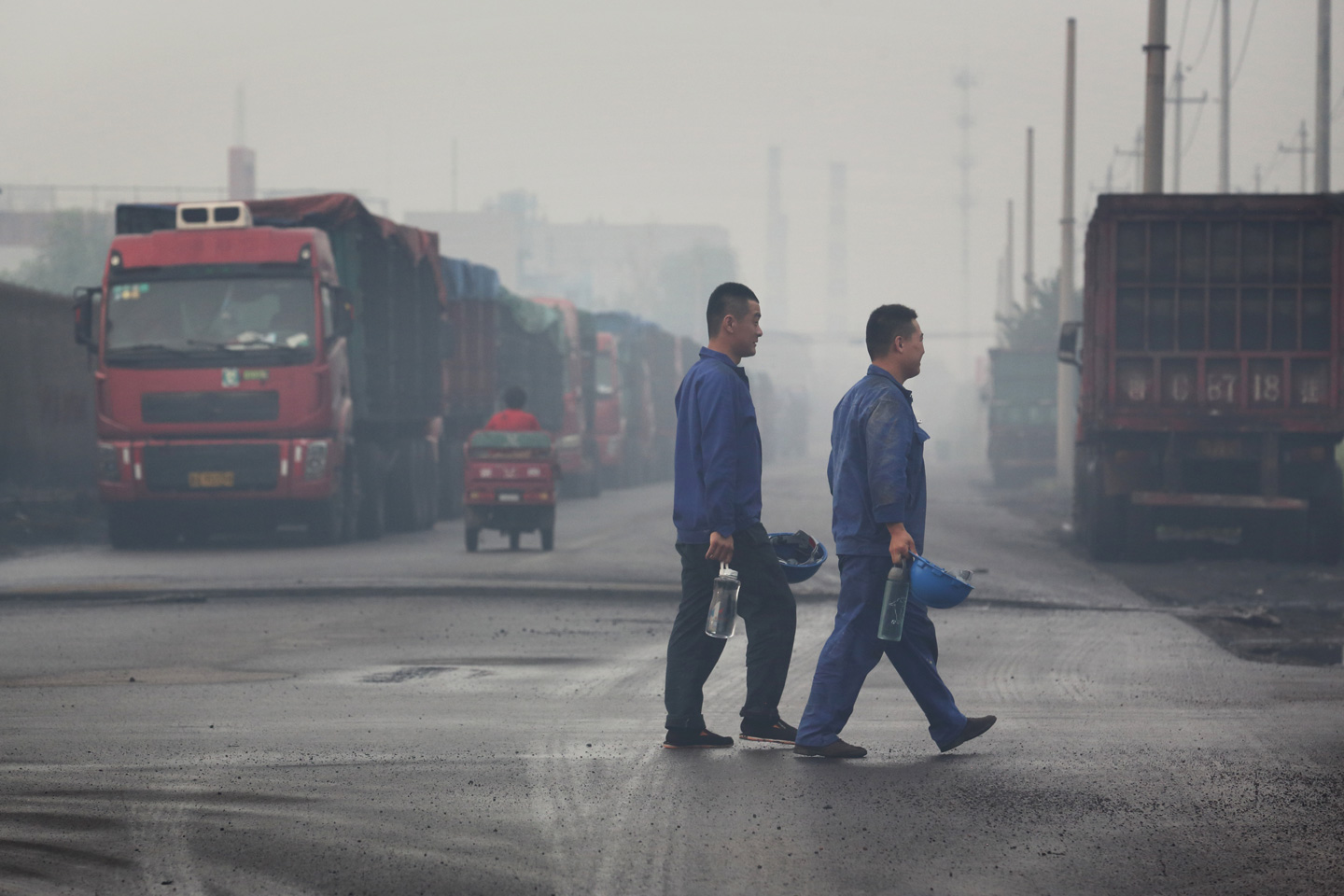
As the Dongyue Group factory is enveloped in thick haze, workers just coming off the night shift are heading home.Image: JIANG MEI/CHINA FILE/THE INTERCEPT
The EPA action that marked the beginning of the end of PFOA and PFOS in the U.S. might have raised red flags about the chemicals here, too. At least one Chinese news outlet, the Shanghai Star, covered the story in July 2004, when the EPA first charged DuPont with failing to report the risks of PFOA. Although it described the chemical as posing “a potential threat to health,” the Star noted that the Chinese government didn’t have the technology necessary to do its own safety tests.
DuPont’s international messaging team was quick to fill in the blanks. Shortly after the news broke, two senior staff members from DuPont’s Beijing office took part in a talk show on sina.com, one of the largest Chinese-language websites, offering assurances that there was no link between PFOA and health hazards and noting that “administrative reporting requirements in the U.S.” had led to a “misunderstanding about the quality of the products.” On its Chinese website, DuPont proclaimed that the company had used the chemical “safely” for 50 years and, according to the story, that “there is no PFOA in Teflon product.”
Neither statement was true — there were trace amounts of PFOA in Teflon, and DuPont had known for years about the health effects of PFOA on its workers and lab animals. But the effort seems to have quelled any nascent controversy in China over the chemical.
In an emailed statement, a DuPont spokesperson wrote that the company “always acted responsibly based on the health and environmental information that was available to the industry and regulators about PFOA at the time of its usage.”
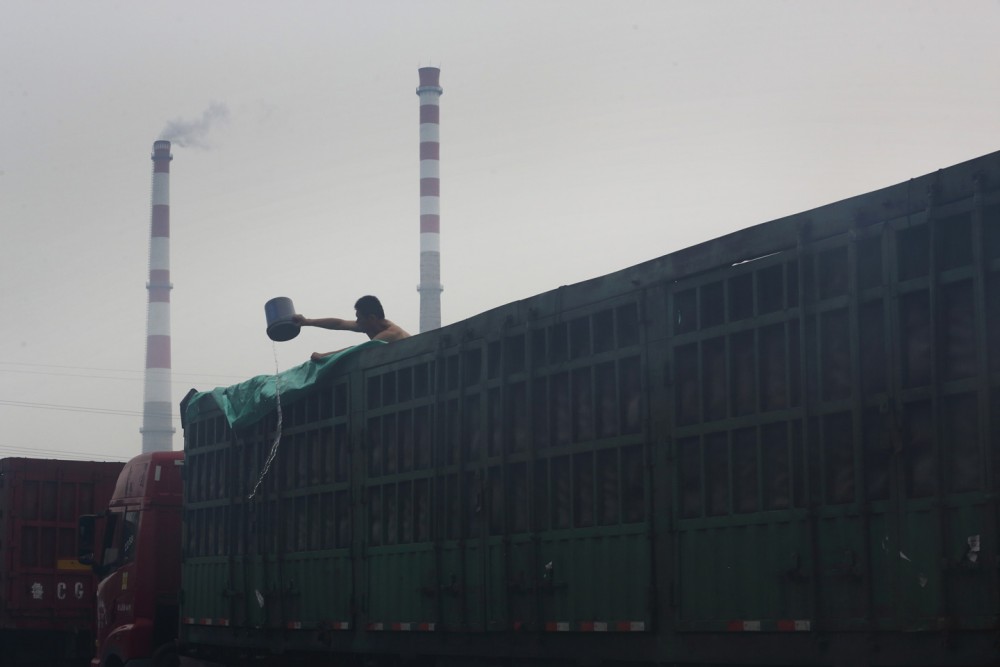
The driver of a Dongyue Group cargo truck cleans up rainwater from the previous night.Image: JIANG MEI/CHINA FILE/THE INTERCEPT
Although Yongqi Guo runs the only NGO devoted to industrial pollution in Shandong province, which is home to more than 100 million people and the factory that emits more PFOA than any other in the world, he hadn’t heard of the chemical or any of the other PFCs. Guo, who met me in the city of Jinan and walked with me along the bank of the Xiaoqing River, founded Green Qilu in 2012 and since then, has had his hands full with everything from water testing to caring for people living in several “cancer villages” in the heavily industrialized province.
Small organizations like Guo’s, which has only four full-time staff members, often rely on volunteers. More than 100 have come forward to help Green Qilu. For now, most pitch in by participating in the “black and smelly river project,” which involves visiting local waterways and reporting on whether they reek or have an odd color. The project, which is sponsored by the central government’s Ministry of Environmental Protection, has already yielded an alarming picture of the extent of water contamination nationwide. But going further — figuring out which particular contaminants are causing the changes or taking steps to remove them — is a trickier business.
Part of the problem is financial. It’s expensive to train volunteers and test water for individual chemicals. The Chinese government made a huge step in 2013 by requiring factories not only to perform certain tests on their wastewater but also to make the water itself available for independent testing. Environmentalists around the country, including Guo, have begun to collect samples. But, while more than 40,000 types of chemical products are made in China, Guo can usually only afford to test for one or two and sometimes opts for tests that simply characterize the water as good, fair, or poor.
An even bigger challenge is a fear of reprisal that hovers over environmental work in China. Businesses often don’t take kindly to citizen oversight. And if protestors are perceived as undermining the government, the consequences can be dire. Guo said Green Qilu’s volunteers wouldn’t be comfortable investigating industrial water contamination because “they’re hesitant that the factories will do something to them or their families.” And even though he is careful to file all the appropriate papers and follow all government regulations, he sometimes worries that the work will somehow cause problems for his own family.
Simply documenting levels of various substances in air, soil, and water can be a risky pursuit. Several of the Chinese researchers I spoke with who track the presence of PFOA said they didn’t want to be mentioned by name. And one environmentalist, Mao Da, told me of his difficulties finding epidemiologists to work on a survey of people living near waste incinerators. “The university professors didn’t want to do it because they didn’t want to have trouble,” Da said, adding that “data collection can be very hard because the local government may try to stop you.”

The Fushan River is heavily polluted.Image: JIANG MEI/CHINA FILE/THE INTERCEPT
Despite the potential consequences of sticking their necks out, many have. In recent years, environmental protests have become the most common form of public demonstration, which has helped bring the country to a distinct turning point. While activists still sometimes face arrest and detention, Chinese authorities seem increasingly tolerant of their occasional outbursts and view pollution itself as a greater threat to the social order than protests over it.
The country’s new environmental protection law, which went into effect last year, may be the best evidence of the seriousness with which the Chinese government is now approaching the crisis. The law lifted what had been a low ceiling on fines that government officials could impose on polluters and for the first time authorized environmental organizations to sue over pollution. The first successful verdict came in June.
The youth of the environmental movement and the severity of the mess it has sprung up to address make this an odd — and, in some ways, hopeful — moment for China. “It’s like the late ’60s in America,” said Ma Jun, director of the Beijing-based organization the Institute of Public and Environmental Affairs. “The issue is so bad and so obvious,” it’s become virtually impossible to ignore. “We feel quite lucky. It’s one of the few areas where we have so much social consensus.”
Ma has been thinking about China’s pollution problem for a long time, first as a journalist, and for the past 10 years, as head of the venture that came up with perhaps the cleverest way to fix it. To Ma, the most vexing aspect of China’s situation was the lack of transparency. Large companies throughout the world had outsourced their dirty chemical work to China, but few were keeping track of what these companies were doing with their waste. The big foreign companies sometimes didn’t even know which companies were supplying their chemicals, let alone what their environmental practices were. “The supply chain was a black box,” said Ma.
IPE has managed to shine light into that box by harnessing both the Chinese government’s amped up commitment to tracking pollution and the internet’s power for public shaming. The organization created a databasethat allows multinational and local brands to see whether their Chinese suppliers comply with the law, using data that factories are now obligated to report about their waste. It also synthesized information on companies such as Adidas, H&M, Zara, and Dell — whether they screen their suppliers or even attempt to identify pollution problems, for instance — into handyonline charts available in English.
Unfortunately, IPE’s online tool has very little information on PFOA or PFOS, since reporting on the use of these chemicals is still voluntary. But you can get a sense of some of the companies that still use these chemicals from the EPA’s website.
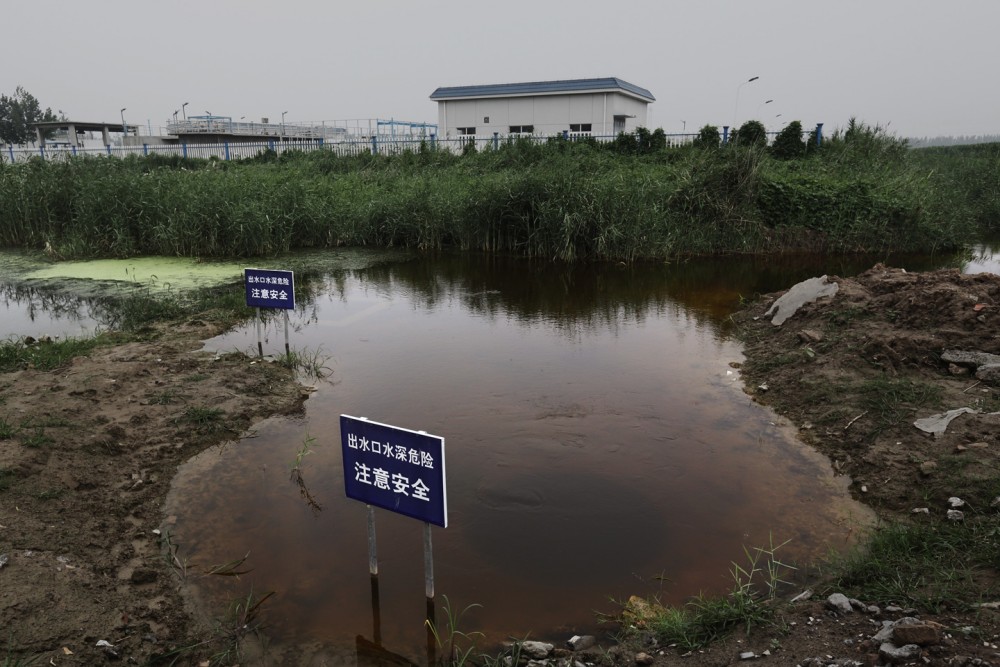
A wastewater discharge site near the Zhulong River. The signs read "Danger: Discharge Site with Deep Water. Take Caution."Image: JIANG MEI/CHINA FILE/THE INTERCEPT
Last January, the EPA issued a rule limiting products containing PFCs based on chains of seven more carbons. (PFOA and PFOS have eight.) As a result, companies wishing to import any materials made with long-chain PFCs would have to request exemptions. The list of manufacturers and industry groups that did includes Texas Instruments, the Motorcycle Industry Council, Tyco Fire Protection Products, Gelest, Hewlett Packard, the High Speed Wax Company, Intel, the Outdoor Power Equipment Institute, the American Coatings Association, and the Semiconductor Industry Association.
In some cases, the rationale for requesting an exemption seemed to be based on the unique qualities of PFCs. (PFOA gives ski racers an inimitable glide, for instance.) But for many manufacturers, the challenge appeared to be logistical. A letter from the Association of Global Automakers described the average car as “a complex web of systems and networks, containing more than 30,000 unique components sourced from thousands of suppliers around the world.” Thus, it concluded, removing the chemicals would pose “significant challenges to the automotive sector.”
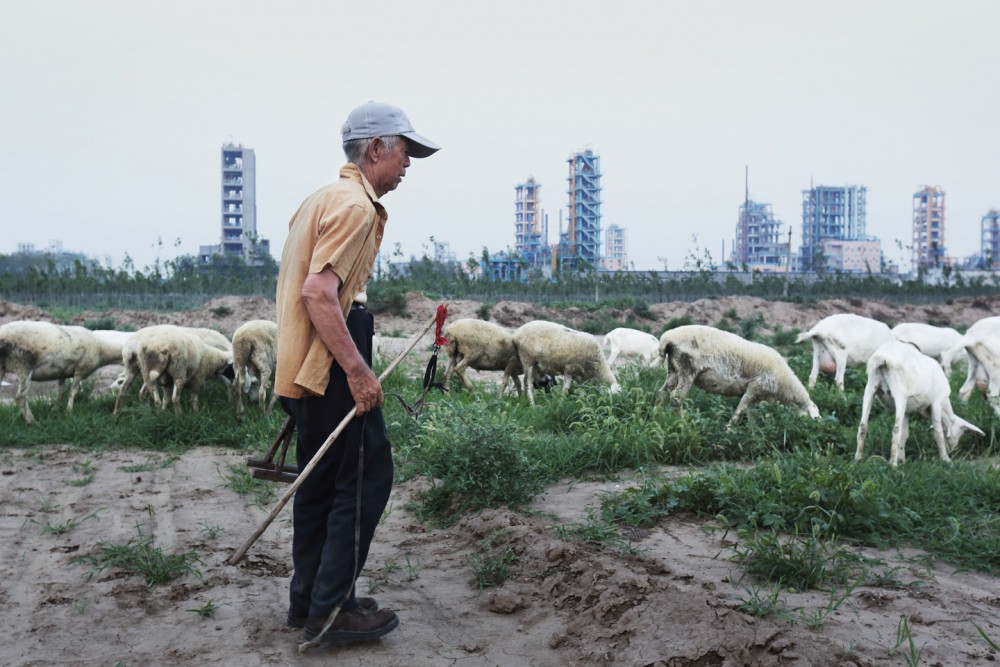
A villager living in Dongba village outside Zibo, Shandong, raises sheep for a living near a chemical plant owned by the Dongyue Group.Image: JIANG MEI/CHINA FILE/THE INTERCEPT
Given the heft of the industries and the number of countries involved in the chemical trade, it would be folly to think that China — or any nation — could tackle the problem alone. This was the idea behind the Stockholm Convention, a treaty adopted in 2001 as a way for countries to collectively stop the migration of toxic chemicals, which move across borders not just by way of changing regulations and market forces but also wind and ocean currents. The convention focuses on chemicals that persist in the environment and build up in people’s bodies. PCBs and DDT were among the first “dirty dozen” it targeted.
But even with the backing of 179 countries, including China, the Stockholm Convention has made slow progress. The convention added PFOS to the list of substances to be restricted in 2009. Implementation of the order didn’t begin until 2014. Even then, industries petitioned for exemptions, and loopholes were carved out for the use of PFOS in firefighting foam, liquid crystal displays, color printers, and decorative plating. A precursor of PFOS can still be used to control red fire ants, and China ships between 30 and 50 tons of it each year to Brazil, which has used and then dumped much of the stuff.
When I visited the office responsible for implementing the Stockholm Convention in China, on the outskirts of Beijing, the staff had recently finished hosting a delegation from North Korea. To put the enormity of their burden in some perspective, they had been coaching the North Koreans on how to eliminate PCBs, chemicals the rest of the world stopped making decades ago. In addition to overseeing the Stockholm Convention project throughout the Pacific region, which includes many countries that are much further behind in terms of eliminating the chemicals than China, the office is also responsible for administering the Basel Convention, a separate treaty governing the transnational movement of hazardous waste.
All of which helps explain why their efforts to reduce PFOS in China through the convention are just getting underway. “We’re just in the beginning to investigate how much of the chemical occurs,” one staff member told me. “China is a very big country. We have a lot of industry. We need some time.”
In the coming weeks, a committee is expected to take the first steps toward adding PFOA to the convention’s list. Though participating governments probably won’t make a final decision until at least 2019, it seems likely that at some point not too far in the future, that chemical, too, will start inching closer to elimination.

Chemical plants in the Changshu Advanced Materials Industrial Park.Image: JIANG MEI/CHINA FILE/THE INTERCEPT
This is often how things work for toxic leftovers; as constraints on them grow, many chemicals wind up coming to China just to die a slow death.
“The country may get a few years out of it,” IPEN’s DiGangi said of PFOS, which itself was a substitution for another chemical, Halon, that was produced in China and phased out in the 1980s because it was depleting the ozone layer. For the PFCs, foreign companies have already taken the next step, replacing PFOA and PFOS with similar molecules that are based on shorter-carbon chains. DuPont, for instance, swapped out PFOA for a chemical it calls GenX.
Indeed, Ni Jiahui, the director of the Changshu industrial park, said that because of safety concerns, both PFOS and PFOA have now been replaced with shorter-chain PFCs. The most recent testing, done in 2012, showed both these replacement molecules and PFOA were present in the water around the park.
While new testing could help clarify that the park has since exclusively switched to shorter-chain replacements such as GenX, it’s difficult to confirm whether companies have phased out chemicals. For instance, one group of German scientists led by Franziska Heydebreck recently measured extremely high levels of 8- and 10-carbon chain compounds inside a Chinese textile manufacturing plant that supposedly had switched to shorter-chain replacement PFCs.
Because many of the shorter-chain PFCs do not appear to be much safer than PFOA and PFOS, even if companies do switch to these molecules, they will likely wind up having to swap out these replacements as they are targeted for global elimination.
The justification for adopting these cast-off chemicals is financial, of course. Yet, many of the leftovers that were big moneymakers in their earlier years aren’t as lucrative in the last stage of their lives. As China has become the main producer of Teflon in recent years, its price has dropped.
Whether because of this or the broader economic forces that have squeezed the Chinese chemical industry, business was slow for the family living on the boat under DuPont Bridge. In the past month, the woman said, she had ferried only a single load of chemicals over the canals of the Changshu industrial park and was worried about how her family would survive.
A few miles away, in a hotpot restaurant in the small city of Fushan, two men also pondered the business of making a living at the chemical park. The name “Fushan” translates to “Fortune Mountain.” But given its proximity to the factories that make PFCs, some locals have darkly joked that the town ought to be called “Fluorochemical Mountain,” which sounds very similar in Chinese.
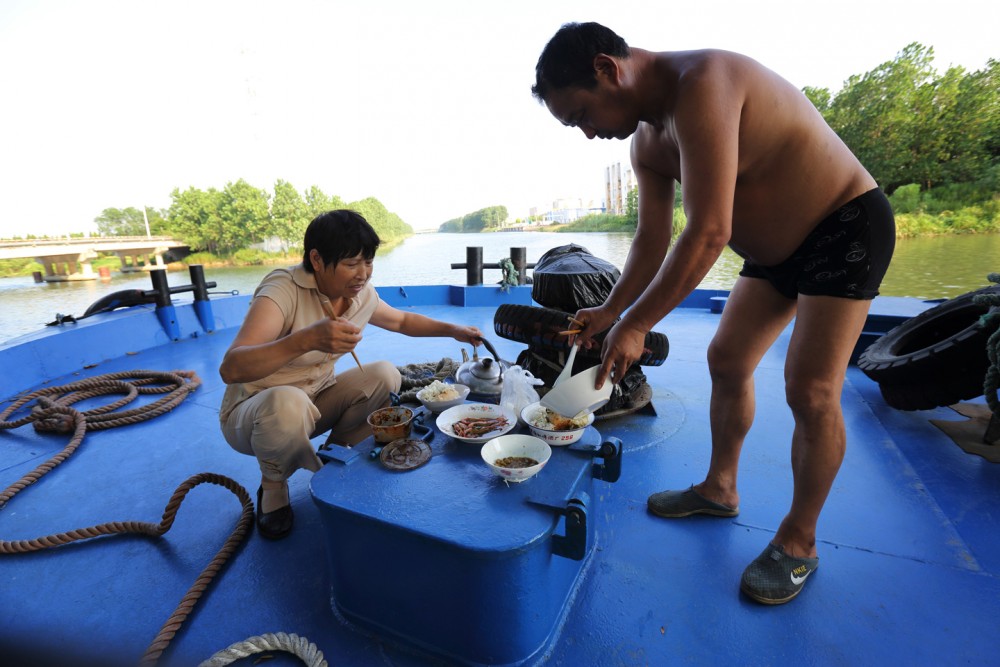
A couple waits on the Fushan River for assignments transporting chemicals.Image: JIANG MEI/CHINA FILE/THE INTERCEPT
One of the men worked in the park and admitted that he sometimes worried about his health. Still, the job paid 5,000 yuan a month (about $750), which he felt was worth the risk. His friend, who sat across a steaming metal dish of noodles and vegetables, vehemently disagreed. “Already Fushan is so renowned for its pollution local farmers can’t sell their fruit or vegetables if people realize they’re from here,” he said. “More dangers surely lie ahead.”
The argument briefly grew heated, as the two men raised their voices and put down their chopsticks. But the factory worker put an end to it with an analogy: “It’s like walking down the road,” he said, as they returned to their meal. “There’s always a chance you might get hit by a bus, but still you walk.”
The analogy doesn’t hold up. China faces far more than the possibility that these toxic chemicals will spread throughout the country. They already have, exposing Chinese people to PFCs without their knowledge or consent. It’s much the same predicament Americans were in 15 years ago, except that this time scientists have a far greater understanding of the dangers posed by the molecules being released into water and soil. And even as international experts prepare to hammer out which chemicals to tackle next and the Chinese government slowly brings its immense power to bear on the pollution problem, they continue to accumulate.
Back in Cuijia, the situation is already urgent. According to Wu, young people in the village decided their best shot — the only one in their power, really — was to leave. Most have. Not long ago, Wu’s own son set off to become an itinerant worker, a life he hopes will be safer than relying on the polluted Xiaoqing River.
This article was reported in partnership with The Investigative Fund at The Nation Institute, now known as Type Investigations and ChinaFile.
Research: Coco Liu